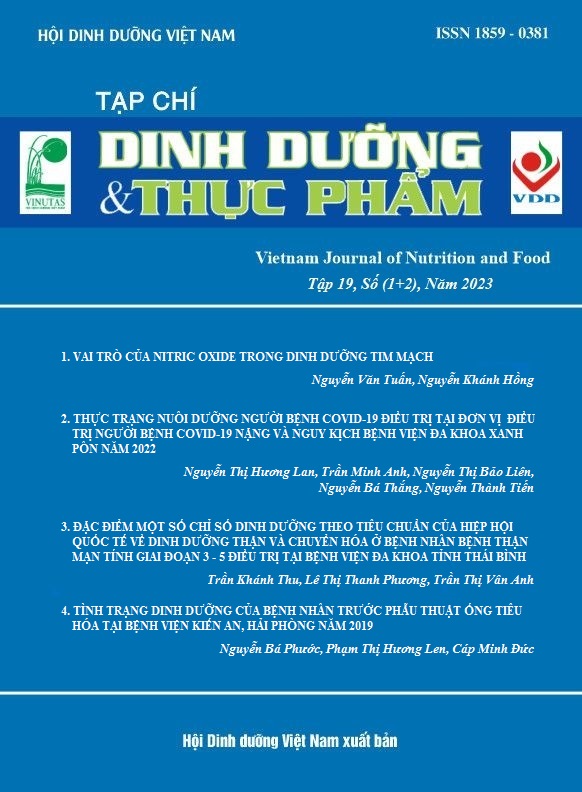FACTORS RELATED BETWEEN EATING HABITS AND OVERWEIGHT-OBESITY STATUS TO DYSLIPIDEMIA PATIENTS AT 108 MILITARY CENTRAL HOSPITAL
Main Article Content
Abstract
Aims: This study aims to learn about factors related between eating habits and overweight obesity status to dyslipidemia patients at 108 Military Central Hospital.
Methods: The cross-sectional study was conducted with 185 dyslipidemia patients in 108 Military Central Hospital from June, 2022 to December, 2022.
Results: Prevalence of overweight-obesity was 38.3%. There was a significant associaion of overweight-obesity status with frequent cravings (OR=3.2), frequent intake of sweet products (OR= 5.4), high-fat foods (OR=4.0), and sea foods (OR= 4.8).
Conclusion: Prevalence of overweight-obesity in dyslipidemia patients was high. An significant association was found between overweight-obesity status with frequent cravings, frequent intake of sweet products, high-fat foods, and sea foods.
Keywords
Eating behaviors, overweight-obesity, dyslipidemia, 108 Military Central Hospital
Article Details
References
2. Phạm Duy Tường và cộng sự. Nghiên cứu hiệu quả qui trình tư vấn dinh dưỡng dự vào bằng chứng, cải thiện tình trạng rối loạn lipid máu ở người trưởng thành. Đề tài nhánh cấp nhà nước. 2010; KC.10.05/06-10.
3. Lin CF, Chang YH, Chien SC. Epidemiology of dyslipidemia in the Asia Pacific region. International Journal of Gerontology. 2018;12(1): 2-6.
4. Aekalkom W, Chaiyapong Y, Neal B et al. Prevalence and determinants of overweight and obesity in Thai adults: results of the Second National Health Examination Survey. J Med Assoc Thai. 2004; 87(6): 685-693.
5. Te Morenga LA, Howatson AJ, Jones RM et al. Dietary sugars and cardiometabolic risk: systematic review and meta-analyses of randomized controlled trials of the effects on blood pressure and lipids. The American journal of clinical nutrition. 2014;100(1): 65-79.
6. Khuyến cáo về chẩn đoán và điều trị rối loạn lipid máu 2015 – Hội tim mạch học Quốc gia Việt Nam.
7. Cristina SM, Adriana LP, Domingo OB et al. Gender Differences in the Diagnosis of Dyslipidemia: ESCARVAL-GENERO. International Journal of Environmental Research and Public Health. 2021;18(23): 12419.
8. Bays HE, Toth PP, Kris PM et al. Obesity, adiposity, and dyslipidemia: a consensus statement from the National Lipid Association. Journal of Clinical Lipidology. 2013;7(4): 304–383.
9. Susetyowati, Emy H, Bernadette JK. Association of Eating Pattern and Nutritional Status with Dyslipidemia Among Adults in Yogyakarta – Indonesia. The UGM Annual Scientific Conference Life Sciences 2016.
10. Trần Đình Thoan. Hiệu quả của truyền thông tích cực, can thiệp chế độ ăn cải thiện tình trạng rối loạn chuyển hóa lipid máu ở người cao tuổi tại nông thôn, tỉnh Thái Bình. Luận án Tiến sĩ Y học, Viện Dinh dưỡng Quốc gia, 2021.
11. Jonathan Buckley. Availability of high-fat foods might drive the obesity epidemic. Nature Reviews Endocrinology. 2018;14(10): 574–575.
12. Mohammad AB, Asgarian A, Moshir A et al. Fast food consumption and overweight/obesity prevalence in students and its association with general and abdominal obesity. Journal of Preventive Medicine and Hygiene. 2018; 59(3): 236–240.
13. Trịnh Thị Ngọc Huyền, Nguyễn Trọng Hưng, Nguyễn Huy Bình. Tình trạng dinh dưỡng và một số yếu tố liên quan của bệnh đái tháo đường type 2 điều trị tại Bệnh viện Nội tiết Trung ương năm 2020. Tạp chí nghiên cứu y học. 2021;146 (10): 150-157.


